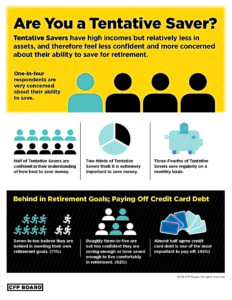Are you a tentative saver? Do you even know what that means? According to the CFP Board, a tentative saver is someone who sets aside money regularly but doesn’t feel as though he or she is saving enough. In fact, 71% of these people believe they’re behind in meeting their own retirement goals. And 62% are not confident they are saving enough or have saved enough to live comfortably in retirement.
Still unsure you fall into this category? Let’s play a little game. Close your eyes and picture the amount of money that is currently residing in your 401K. Now, picture the amount or percentage you contribute. Got it? Awesome! Open your eyes.
When you saw that number in your mind’s eye, did you grin a little, comfortable with the amount and confident you’ll be able to contribute more soon? Or, did you cringe, knowing you should contribute more but worried it may affect other aspects of your fiscal life?
This anxiety may be creeping in because your paycheck is mainly going toward your monthly expenses, including student loans. Many young people in their 20s and 30s are struggling to pay off student loans, so the ability to save isn’t an option or, at least, this demographic doesn’t consider it a priority. Tackling financial setbacks can be a hurdle, but not an impossible one.
Here’s how to avoid being a tentative saver.
First, create a concrete plan of action for yourself. You can do this by using financial calculators and tools that can help you set budgets for yourself to help curb unnecessary spending so you can save for the future. Or, you can just ask your trusty neighborhood financial planner for advice. We’re trained to provide you with a road map for financial decisions.
Next, consider how much each of your goals will cost you and what your time frame for completing them is. When it comes to student loan debt, many lender websites have a debt calculator that allows you to estimate roughly how long it will take you to pay off the debt. Utilize this tool as you review your financial goals.
Finally, rank each of your financial goals and decide which of them is currently most important to you and your family. While purchasing the largest TV might be a dream of yours, but the latest smart TV isn’t a necessity. Look closely at what you’re paying in essential monthly expenses, then look at how much you’re saving. You may find that you have more wiggle room in terms of paying yourself than you thought possible.
Related Articles
[CNBC] How to Prioritize Retirement Savings? Try These 3 Steps
[Good Morning America] VIDEO: How to Save Big For Retirement
[Barron’s Next] How to Save Money When You Don’t Have Much to Save
[The Fiscal Times] Self-employed? Here’s How to Save for Retirement

